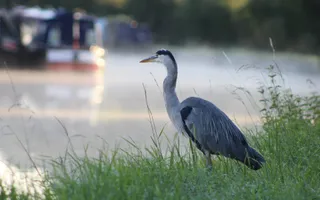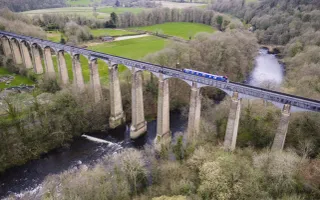The UK faces an unprecedented convergence of crises: a decline in biodiversity, people losing their connection to nature, and widening wellbeing inequalities. The Vital Connector for Nature and People report, backed by respected peers including Dr Tony Juniper CBE, chair of Natural England, says that canals hold a uniquely powerful role in addressing all three.
As 250-year-old humanmade structures, these important habitats need constant care and maintenance by the Canal & River Trust and the thousands of volunteers who support the charity. The case for support has never been stronger, and the report sets out how funders, partners and the public can get involved in maximising the opportunities canals offer.
Valuable ecological systems
Campbell Robb, our chief executive, said: “Our canals are a legacy of Britain’s industrial past, but they’re also a blueprint for its environmental future. Stretching from the heart of cities to the rural countryside, they form an unbroken network that connects landscapes, communities, and habitats.
“These humanmade waterways are now one of the nation’s most valuable ecological systems, home to rich biodiversity. You don’t have to go to a national park to feel nature’s benefits: our canals bring wildlife right into people’s daily lives._
“The canal network has long been an undervalued asset, its role in nature recovery and connectedness overlooked. With the right investment, it can be the nation’s most powerful network for nature recovery and wellbeing, reconnecting millions with the living world on their doorstep.”
Nature in the heart of our towns and cities
Tony Juniper said: “We can connect up the landscape through the use of infrastructure, with wildlife corridors that are attached to what are already linear features running through the landscape: alongside railways, highways, and, of course, by canals. That’s why it is so important for the Canal & River Trust to be participating in the national programme to create a nature recovery network. Wildlife can live very close to people, even in the heart of our towns and cities, especially if we harness this green infrastructure to be not only beautiful, but to be connecting up the landscape and thereby contributing to nature’s recovery.”
Built during the 18th and 19th centuries as vital transport routes, today a new kind of heritage has emerged, blending industrial engineering with ecological restoration. The canal network has become one of the UK’s most important ecological corridors, providing critical habitat for wildlife across cities, towns and countryside.
Essential for people
Our 2,000-mile network is a continuous system of canals, banks, towpaths and hedgerows that supports a diversity of life, from bats, kingfishers and otters to aquatic plants, pollinating insects and rare invertebrates. As linear corridors, they reconnect otherwise fragmented landscapes, allowing species to move freely across urban and rural areas. This is especially true in the post-industrial and intensively farmed lands of middle England, where the canal network is centred.
Canals are also essential for people, with research showing that access to green and blue spaces is a key determinant of health. Yet access remains unequal: many urban and minority communities have fewer outdoor spaces. Canals can help bridge that gap, with just under nine million people living within a 15-minute walk of their local canal, many in areas with limited green space and poorer health outcomes. The Canal & River Trust’s Canals on Prescription and Community Roots programmes are already demonstrating how canal spaces can deliver measurable improvements in mental health and wellbeing. With targeted investment, canals can become a cornerstone of the nation’s preventative health infrastructure.
Keep canals thriving
We're inviting funders, partners and the public to join its mission to keep canals alive and thriving. Opportunities include:
- Restoring habitats and species, from improving Sites of Special Scientific Interest to supporting the recovery of water voles and pollinators.
- Improving water quality and connectivity via fish and eel passes, sediment remediation, and targeted land management.
- Expanding citizen science, enabling volunteers to map, monitor and improve local canal habitats.
- Connecting people with nature through expanded programmes for young people, nature-based health interventions, and community engagement.
Campbell Robb added: “Many people don’t realise that our canals need constant care and maintenance to keep them available to all. We need investment, partnerships and public support guarantee their future. Every person who donates, volunteers, or takes action helps us to protect this extraordinary network.”
Our Vital Connector for Nature and People report presents the body of evidence on the ecological value of the canal network and highlights the breadth of opportunities for contributing to nature recovery and fostering people’s connection to nature.





